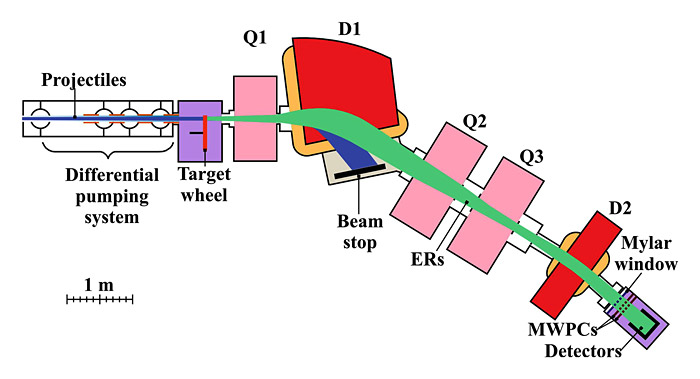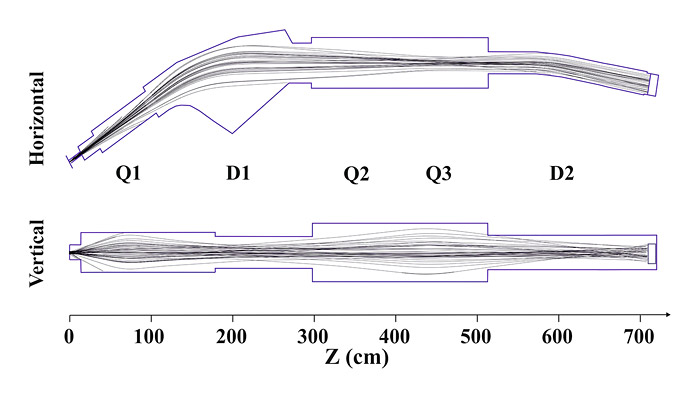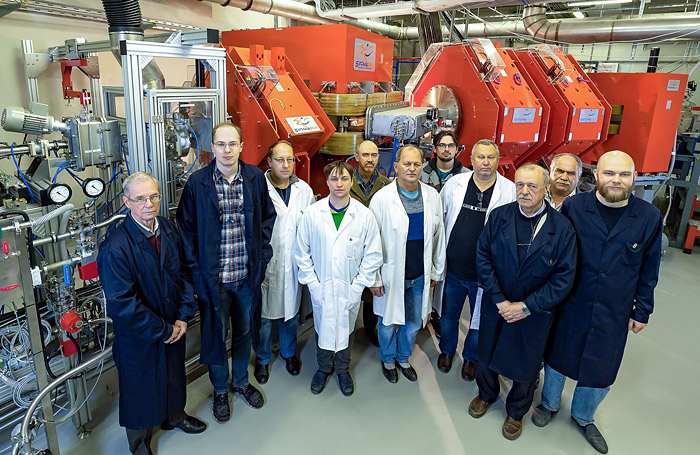
Electronic english version since 2022 |
The newspaper was founded in November 1957
| |
JINR Prizes
DGFRS-2 is the first at the Superheavy Element Factory
A group of scientists from the Laboratory of Nuclear Reactions was awarded the second JINR Prize in 2022 for a series of works dedicated to the design and development of the new Dubna Gas-Filled Recoil Separator DGFRS-2 - the first facility for the synthesis and investigation of the properties of nuclei produced at the Superheavy Element Factory.
Using DGFRS-2, the authors of the separator will reach a new level in the investigation of isotopes of superheavy elements and synthesize new ones - the 119th and 120th. The processes of developing separator units, writing programmes for transporting ions from the target to detectors, as well as a range of test experiments implemented in 2019-2022 are described in the series of articles submitted to the competition of JINR research papers. The results of all this work are being summed up today by FLNR Deputy Director, one of the prize winners Andrey POPEKO.
As a result of experiments started in 2000 at the U-400 accelerator and the DGFRS separator, the boundaries of the area of the heaviest nuclei were significantly expanded. Six new elements up to Og (atomic number 118) were discovered and the properties of more than 50 isotopes of elements from Rf (atomic number 104) and higher were studied. However, scientists were no longer able to synthesize elements with atomic numbers greater than 118, to obtain isotopes of superheavy elements with fewer or more neutrons or to more deeply study the properties of nuclei and the chemical properties of heavy elements at this facility. The sensitivity of the experiment that was considered a record in 2000 was no longer enough for further research.
To increase sensitivity tenfold, it was necessary to develop a new experimental complex "Superheavy Element Factory", the "heart" of which was the DC-280 accelerator with an intensity several times higher than that provided by the U-400 cyclotron. The first facility for the synthesis and investigation of the properties of nuclei at the Factory was the new DGFRS-2 separator, with the efficiency of transporting nuclei to detectors twice as high as the DGFRS-2 separator at the U-400 accelerator.
The general layout of the separator and the design of its optical components were developed at FLNR JINR; the magnets themselves were produced and supplied by SIGMAPHI (France). FLNR departments have developed and manufactured ion guide units, a differential gas pumping system between the separator and the ion guide, chambers for rotating targets, chambers for detectors, a system for pumping gas through the separator, a control system for vacuum units, a magnet control system, others.

Quadrupole lens Q1 focuses the ions emitted from the target in the vertical direction so that most of the synthesized nuclei pass through the gap of the dipole magnet D1. This magnet deflects ions by 31.5° and focuses them in the horizontal direction. The dipole separates the products of full fusion reactions from the beam particles and suppresses most of the other background particles (such as scattered beam and target ions, products of incomplete fusion, others). Quadrupoles Q2 and Q3 focus ions onto a detector positioned in the focal plane of the separator in the horizontal and vertical directions. Dipole D with a deflection angle of 10° additionally suppresses the background from charged particles - alpha particles, protons, others, produced in the reactions of beam ions with gas and the internal walls of DGFRS-2.

When the separator was ready and delivered to the territory of the Institute, we encountered some problems during installation: DGFRS-2 needed to be installed in the cabin on the accelerator and the cabin is relatively small in size. In addition, the main magnet alone weighs 24 tons. A Russian company helped us to raise the separator to the required height, its employees did it very quickly and masterfully. Afterwards, together with our French colleagues, the manufacturers of DGFRS-2, we installed the separator according to the calculated parameters with an accuracy of up to a millimeter, checking it with a laser scanner. By the way, the experience of working with such devices helped us a lot in the future, that is when installing the following facilities, as well as when assembling and repairing accelerators.

To describe the movement of ions in the magnetic fields of the separator, two programmes were developed: the first was developed during the design of the separator, the second was written later based on the GEANT4 software package. The developed programmes allowed to describe with high accuracy the horizontal and vertical distributions of nuclei for various combinations of currents in the magnets, when varying the gas pressure in the separator, to calculate the transmission of ions and to establish current values in various experiments.
New units have been developed for the installation of detectors of different sizes. Due to the increased dispersion of the magnet, the background on the detectors was significantly reduced, but it became necessary to increase the horizontal size of the focal detector. It was assembled from two detectors measuring 48x128 mm2, with strips 1 mm wide at the front and back (DSSD) to determine the position of the nucleus on its surface. The DSSD is surrounded by eight 60x120 mm2 side detectors for additional detection of alpha particles and fission fragments that may be ejected from it towards the separator. The entire assembly looks like a box with five sides, 120 mm deep and open towards the target. To register the arrival of particles from the separator, a system of multi-wire proportional chambers operating at a pressure of 1.6 mbar was developed. The nuclear registration system includes digital and analog electronics that operate independently and allow the beam to be turned off after the decay of the mother nucleus to suppress the background when observing the decay of daughter nuclei.
A system has also been developed that ensures a constant gas flow through the separator, a stable gas pressure in it with a variable set value and the safe use of various gases. Before starting experiments on the synthesis of superheavy nuclei, scientists carried out a range of test experiments. They measured the dispersion of the DGFRS-2 pulse: it determines the required accuracy of magnet tuning in experiments. The value coincided with the calculations. They determined the optimal gas pressure in the separator that significantly affects the value of the separator transmission. They measured the efficiency of accumulating nuclei using DGFRS-2 detectors. If we compare the results of experiments on DGFRS and DGFRS-2 in experiments on the synthesis of muscovium nuclei Mc (element 115) in the 243Am+48Ca reaction, it is clear that the efficiency of the new separator is twice as high. Finally, scientists studied the background conditions at the new separator. They are more than two orders of magnitude lower than what it was in the experiments at the DGFRS.
The entire range of test experiments, as well as the first experiments on the investigation of isotopes of elements 110, 112, 114 and 115 showed that the new experimental complex allows to carry out further research of superheavy nuclei at a much higher level of sensitivity. In the future, it is expected to synthesize heavier elements - 119 and 120. Preparatory work is underway. A programme is currently implemented jointly with Rosatom that is aimed at getting as close as possible to the synthesis of new elements.
Based on the information from JINR Press Office